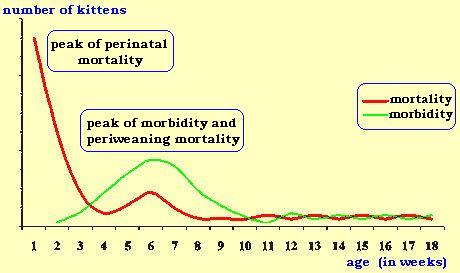The first thirty-six hours of their life, the kittens will profit from the colostrums produced by their mom. The colostrums is a thick liquid rich in proteins and antibodies secreted by the mammary glands after the birth of the kittens, before the milk secretion starts.
Between the birth and the fourteenth day (neonatal period), the kittens sleep and nourish themselves from their mom’s nipples.
About the tenth day, the eyes start opening. In the few days that follow, the first teeth appear. The colouring of the points begins after about fifteen days. It may be earlier for the seal point and the blue point, but later for the chocolate point and the lilac point.
It is important to weigh the kittens on a daily basis, this in order to follow their weight gain. In general, a kitten must double its birth weight after one week. He/she must triple its birth weight after two weeks. Finally, it must quadruple its birth weight after three weeks. Beyond five weeks, another general rule estimates that the kitten must weigh its number of weeks multiplied per hundred grams and added with one hundred grams. For example: a 6 week old kitten should weigh (6 x 100gr) + 100gr. Which gives 700 grams.
After the fourth week, the period of weaning can start. A food known as "wet" will be given to the kittens. This food will be initially very liquid in order not to carry out too quickly a transition with milk from the mom. After a few days, it will not be necessary anymore to add water to wet food (boxes for kittens).
At this age, the kittens are less dependent on their mom. However, they remain much attached. To wander from the nest is frequent. The "adventures" can start! Beyond five to six weeks, croquettes for kittens can be presented. Make sure that fresh and clean water is be placed at their disposal.
Between the 3rd and 7th week, the first phase of socialization takes place. This period is important for the future balance of the cat.
The kitten is educated, in first, by its mom. She will show the maximum of useful things for her offspring. She gives the good example thus to be followed.
Each kitten will have to experience everyday life. It agrees paramount time to the training of the kitten. Indeed, the more a kitten is handled and/or touched, the better the kitten will gain the needed skills for its future life. It is proven that a kitten handled at least three times fifteen minutes per day is much more stable than a kitten which was handled only ten minutes per day. In the same way, for its harmony, it is preferable that the kitten knows the maximum of people and/or children during this period. The kitten will also have to be put in the presence of other cats and dogs in the residence. Moreover, the kitten will adopt a more sociable nature and will adapt more easily to its new family when he/she will be adopted.
Between the seventh and the fourteenth week, the second phase of socialization takes place. During this period, the elements that have not yet been acquired will have to be taught. It definitely will be more difficult than with the kitten which has had prior education.
As the weeks pass, the kittens play together. They nicely scuffle. The mom is also invited to play. As soon as the “playing” goes a little too far, when a kitten feels "wedged" or is nibbled, or if it quite simply feels an unspecified pain, it is automatically withdrawn. At this age, the kitten will have to understand/learn that it cannot bite nor scratch.
Between the ninth and the fourteenth week, the kittens play most of the time. After the twelve weeks age, the plays become less and less peaceful. The "cat-like" character of the adult cat is set up gently. If the kitten were not indeed educated, it will feel the need for being defended towards any potential enemy, like another cat in the house, a dog, or another animal. It is consequently of primary importance that at this age, it knows that he can also play with the other animals of the house.
In order to ensure the best possible socialization and to give the kitten all the necessary vaccines before its departure, our breeders only yield their kittens after the age of thirteen to fourteen weeks. Trust their work and their daily concerns. The price of a kitten is sometimes raised, but by no means compensates for the efforts and the devotion of our breeders.

This table shows very well the death rate of the kittens according to the age. It is to be noticed that the stability begins from the 11th week! We thus take 2 weeks an additional guarantee in order to yield to you a kitten with the maximum of protection.
|